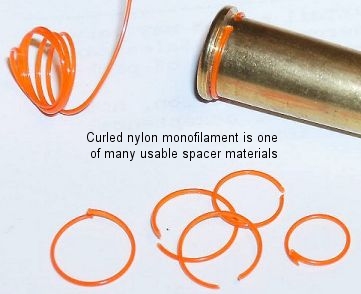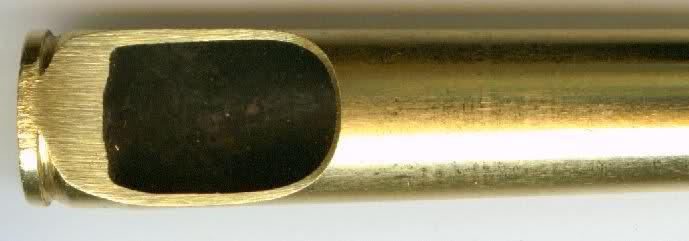-
Legacy Member


What brand of brass are you using? S&B cases are very thin and often have head seperations by the 3rd loading regardless of what the headspace is. Try a different brand and see what happens. You may also try reducing the propellant charge by 1/2-3/4gr. Top end loads will shorten case life.
If you use the o-ring trick as suggested by jmoore to fire form the cases and neck size ( partially full length sizing is ok as long as the shoulder is not set back) case stretching will be minimal.
-
Thank You to vintage hunter For This Useful Post:
-
03-02-2013 03:59 PM
# ADS
Friends and Sponsors

-
Legacy Member


Originally Posted by
bow

But ith o-ring will reduce headspace first time the brass is shot..but the second time , withouth o-ring , it will be stretched ... What i hadn't understood?
The o-ring, in theory, takes up the excess clearance and holds the base of the case back against the bolt face, and allows the neck of the cartridge to fire-form itself forwards to the shape of your chamber.
As V-H says above, for this idea to work, you must then reload using neck-sizing only, so that the shoulder location is unchanged, and at the next firing the case will ,in effect, almost headspace off the shoulder. This will give absolutely minimal stretching of the case, and maximise case life.
If you reload for more than one .303, the downside is that you will likely have to keep brass separate for each rifle, due to the difference in chambers.
Last edited by Maxwell Smart; 03-02-2013 at 04:21 PM.
-
The Following 2 Members Say Thank You to Maxwell Smart For This Useful Post:
-
-
Legacy Member

The problem of "excessive" headspace MAY not be a worn bolt, it may be a worn or stretched BODY (Receiver).
If the bolt is at fault, the solution is to replace it, check the lug bearing, select the appropriate bolthead and carry on. Be aware that ANY lapping in of a new bolt will remove metal and thus open up the headspace, however minutely. Removing metal also thins the already minuscule hardened skin on the bearing surfaces.
Without either a proper "master" bolt or some very fancy metrology, assessing the receiver is tricky. Not the least of the problems is that the locking surfaces are cut on a 1: 0.10" helix, unlike most other types of action.
-
Thank You to Bruce_in_Oz For This Useful Post:
-
O-ring on the front of the rim...pushes case hard against bolt face.

6,5 Japanese in the photo above, but the idea is the same and is more effective in Enfields.
in the photo above, but the idea is the same and is more effective in Enfields.
The only case stretch will be the wee bit from action flex.Nothing to be done about that except swapping your L-Es for No.3 rifles.
-
-
Legacy Member

The trick with the "O" rings is to effectively change the headspace system. Rimmed cases like the .303 headspace, quite literally, using the rimmed head of the case.
Rimless cases like .243 etc, use a bit more geometry to measure between the bolt face and the rear of the cartridge. The rear of the cartridge is defined by a measurement from a specified, precise diameter on the shoulder.
That is why headspace gauges for rimmed cartridges like the .303 are quite short but rimless types look like a bit like a cartridge case without a neck.
The other problem .303 shooters have is that, sometimes, the headspace, as measured by the rim, may be good, but the cases split at the shoulder and bulge at the web. This has been "attributed", especially in WW1 vintage SMLEs, to "relaxations" for "mud-clearance" in the trenches. Old, poorly annealed brass may also crack on the first firing, regardless of the specifications of the chamber.
"Oversized" chambers may also, in many cases, be caused by excessive "cleaming" of the chamber performed AFTER the rifle left miltary service.
-
-
Advisory Panel



Originally Posted by
bow

. . . But ith o-ring will reduce headspace first time the brass is shot..but the second time , withouth o-ring , it will be stretched ... What i hadn't understood?
I suspect what you haven't understood is that the shoulder alone is sufficient to prevent end-play (and consequent stretch). Here's an excerpt from "Headspace 101" focusing on this issue -
. . . If you handload for a .303 with generous headspace, there's no need to mess with bolt heads - changing the rifle's clearances to yield longer case life. You can control head clearance simply by changing technique.
When you fire a new case for the first time, use an improvised spacer ahead of the rim - anything from a precision metal washer to dental floss can work to hold the the cartridge head firmly against the bolt face and eliminate or reduce stretch even if head clearance is significant. Another way of accomplishing the same end is to use a bullet seated out far enough to jam into the lands, "headspacing" on the bullet instead of the case. Such techniques are useful only if the rifle has excess headspace. With normal headspace, initial stretch isn't enough to worry about.

After you've fire-formed your new cases they will fill the chamber fully, stopping on the shoulder just like a rimless cartridge. If you neck size, you'll have zero "headspace". If you have to full length size, adjust the die so the cases chamber with just a bit of resistance in the last few degrees of bolt rotation. . . .
To demonstrate how we can control head clearance using only the shoulder, I filed off the rim of a once-fired Remington .303 case. After adding an extractor groove to fit a Mauser-size shellholder, I neck-sized, reloaded and fired this case 19 more times.

The load was a 180-grain jacketed soft-point over a lightly-compressed charge of IMR 4350 (giving an average velocity of 2310 fps for the 19 shots and listed at just under 39,000 CUP in my IMR data booklet). The test rifle was a 1943 Lithgow S.M.L.E. Mk.III*. 20 shots was enough for a practical test, I sectioned the case to examine the web/body junction area where thinning normally occurs.
S.M.L.E. Mk.III*. 20 shots was enough for a practical test, I sectioned the case to examine the web/body junction area where thinning normally occurs.

This case, fired 19 times with no rim, has not stretched or thinned at all. I'm sure it could have continued for at least another 20 of these moderate loads.
It's clear to me that the .303's shoulder, alone without help from the normal rim, is entirely adequate to maintain "headspace" when sized in a way that preserves the shoulder location. Those handloaders who experience poor case life with neck-sized handloads should look for other factors to explain premature case failures. The most likely source of trouble is high pressure. More pressure means more action flex and that means shorter case life.
-
The Following 7 Members Say Thank You to Parashooter For This Useful Post:
-
FREE MEMBER
NO Posting or PM's Allowed

I used Remington , S&B brass, Norma also. And prvi partizan.. With all those brands the problems occur 1/2 " over the rim. Here brass seeems to enlarge only a few and the brass itself change his colour, becoming more dark. If headspace is set at minimum, colour remains the same and no internal size alteration occur. Finally, minimum heaspace give me minor standard deviation shot after shoot. It grants tighter groups.
---------- Post added at 11:47 PM ---------- Previous post was at 11:42 PM ----------
I forgot to say that i use lee/ rcbs neck sizer only. After 3 shots brass gows up under the neck and enlarge, so i must do a full size. It doesn't happen when headspace is set to minimum.
-
Advisory Panel



Originally Posted by
bow

I forgot to say that i use lee/ rcbs neck sizer only. After 3 shots brass gows up under the neck and enlarge, so i must do a full size. It doesn't happen when headspace is set to minimum.
If you need to full-length size after three shots, you're loading near or above maximum pressure. Use less powder and cases will last longer.
-
Thank You to Parashooter For This Useful Post:
-

Originally Posted by
bow

I forgot to say that i use lee/ rcbs neck sizer only. After 3 shots brass gows up under the neck and enlarge, so i must do a full size. It doesn't happen when headspace is set to minimum.
With the o-ring trick, your cartridge will be set at "0". It doesn't get better than that! And you only need to use the ring for the first firing if you neck size. (I generally only size about 3/4 of the neck.)
-
Thank You to jmoore For This Useful Post:
-
FREE MEMBER
NO Posting or PM's Allowed

I used to get a lot of case-head separations with one particular rifle (a beautiful commercial long Lee). Often they split on the 2nd or 3rd reload, always about 1 cm up from the rim. Neck-resized rounds only fitted this rifle, so I had to segregate my brass which is a headache. I cured the problem by
(1) avoiding buying S&B ammo or reloading S&B cases (switched to Prvi, though I find HXP equally suitable, thick brass)
(2) selling the rifle
All 5 of my .303s now have similar chambers so I neck resize and don't segregate the brass. I just check that the rounds fit the rifle before I go shooting.















 PM
PM
















